Analysis of Communication in Health and Social Care: A Report
VerifiedAdded on 2020/05/01
|8
|1824
|106
Report
AI Summary
This report delves into the multifaceted aspects of communication within health and social care settings. It begins by exploring various communication theories, including Maslow's hierarchy of needs, behaviorist theory, and Kolb's learning cycle, highlighting their application in identifying and addressing individual needs. The report then examines the influence of values and cultural factors on communication, emphasizing the importance of cultural competence and sensitivity in healthcare interactions. Furthermore, it analyzes the impact of charters, legislation, and codes of practice on the communication process, underscoring the significance of ethical and legal considerations. Finally, the report evaluates the effectiveness of organizational systems and policies in promoting good communication practices, including various communicative approaches like oral, written, and electronic communication, to ensure effective patient care and professional conduct within health and social care environments.
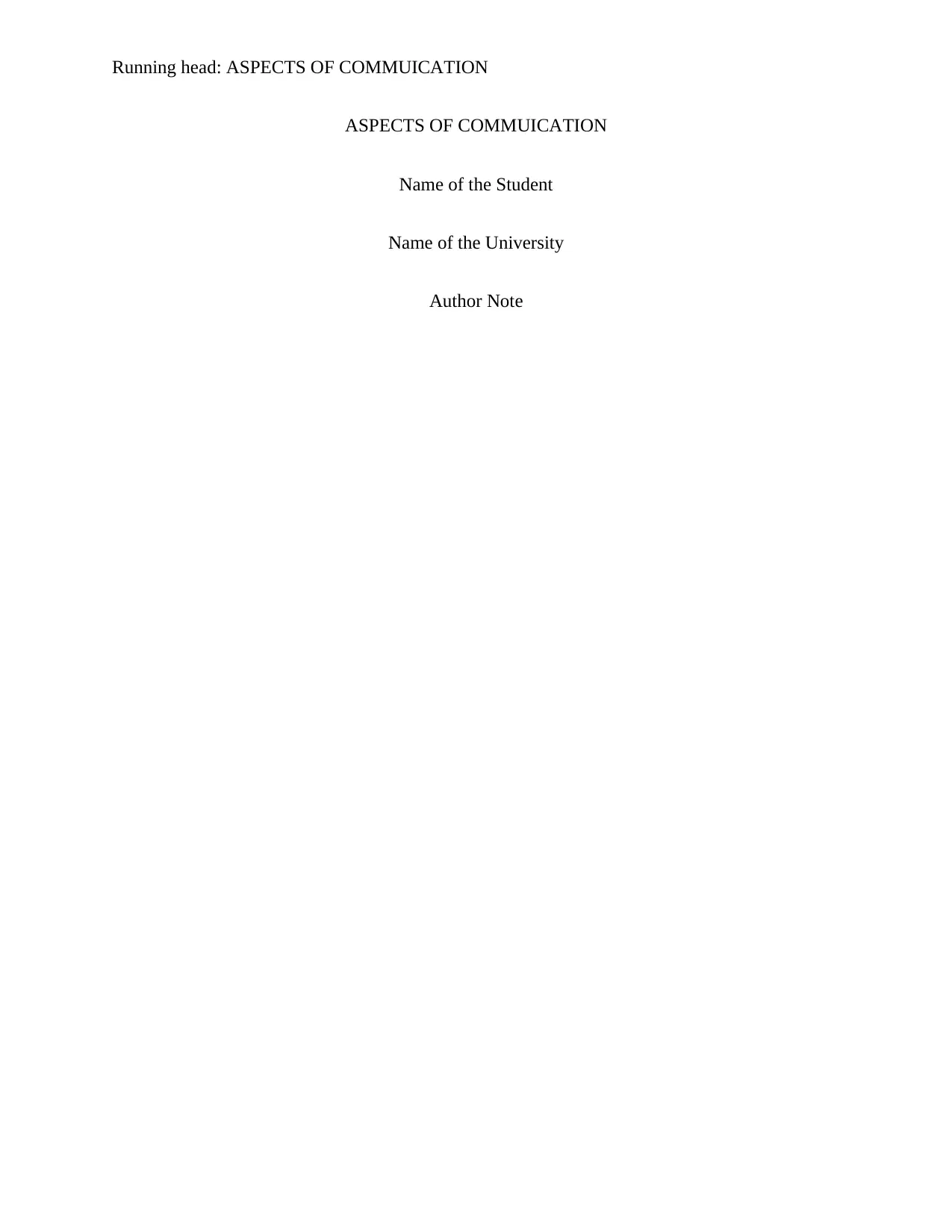
Running head: ASPECTS OF COMMUICATION
ASPECTS OF COMMUICATION
Name of the Student
Name of the University
Author Note
ASPECTS OF COMMUICATION
Name of the Student
Name of the University
Author Note
Paraphrase This Document
Need a fresh take? Get an instant paraphrase of this document with our AI Paraphraser
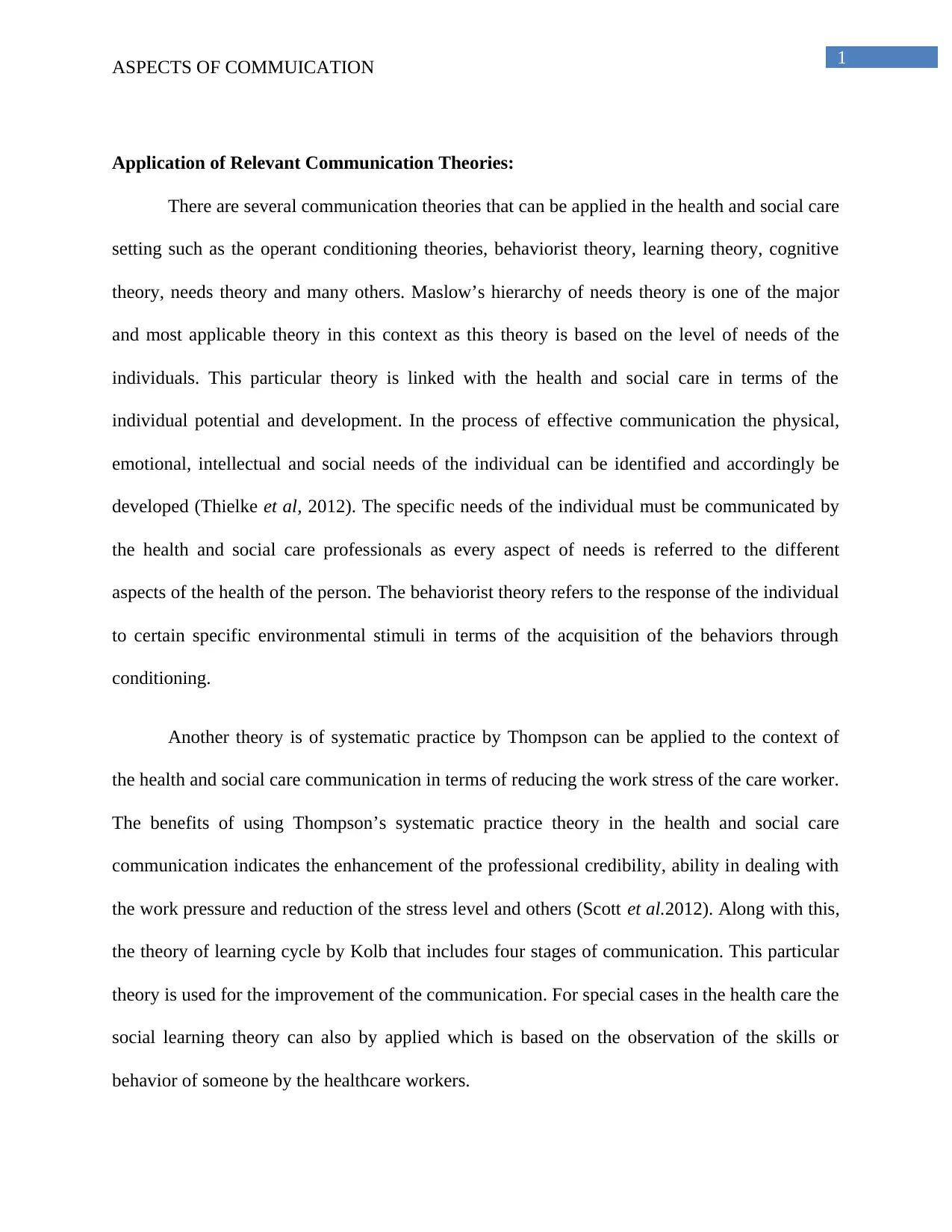
1
ASPECTS OF COMMUICATION
Application of Relevant Communication Theories:
There are several communication theories that can be applied in the health and social care
setting such as the operant conditioning theories, behaviorist theory, learning theory, cognitive
theory, needs theory and many others. Maslow’s hierarchy of needs theory is one of the major
and most applicable theory in this context as this theory is based on the level of needs of the
individuals. This particular theory is linked with the health and social care in terms of the
individual potential and development. In the process of effective communication the physical,
emotional, intellectual and social needs of the individual can be identified and accordingly be
developed (Thielke et al, 2012). The specific needs of the individual must be communicated by
the health and social care professionals as every aspect of needs is referred to the different
aspects of the health of the person. The behaviorist theory refers to the response of the individual
to certain specific environmental stimuli in terms of the acquisition of the behaviors through
conditioning.
Another theory is of systematic practice by Thompson can be applied to the context of
the health and social care communication in terms of reducing the work stress of the care worker.
The benefits of using Thompson’s systematic practice theory in the health and social care
communication indicates the enhancement of the professional credibility, ability in dealing with
the work pressure and reduction of the stress level and others (Scott et al.2012). Along with this,
the theory of learning cycle by Kolb that includes four stages of communication. This particular
theory is used for the improvement of the communication. For special cases in the health care the
social learning theory can also by applied which is based on the observation of the skills or
behavior of someone by the healthcare workers.
ASPECTS OF COMMUICATION
Application of Relevant Communication Theories:
There are several communication theories that can be applied in the health and social care
setting such as the operant conditioning theories, behaviorist theory, learning theory, cognitive
theory, needs theory and many others. Maslow’s hierarchy of needs theory is one of the major
and most applicable theory in this context as this theory is based on the level of needs of the
individuals. This particular theory is linked with the health and social care in terms of the
individual potential and development. In the process of effective communication the physical,
emotional, intellectual and social needs of the individual can be identified and accordingly be
developed (Thielke et al, 2012). The specific needs of the individual must be communicated by
the health and social care professionals as every aspect of needs is referred to the different
aspects of the health of the person. The behaviorist theory refers to the response of the individual
to certain specific environmental stimuli in terms of the acquisition of the behaviors through
conditioning.
Another theory is of systematic practice by Thompson can be applied to the context of
the health and social care communication in terms of reducing the work stress of the care worker.
The benefits of using Thompson’s systematic practice theory in the health and social care
communication indicates the enhancement of the professional credibility, ability in dealing with
the work pressure and reduction of the stress level and others (Scott et al.2012). Along with this,
the theory of learning cycle by Kolb that includes four stages of communication. This particular
theory is used for the improvement of the communication. For special cases in the health care the
social learning theory can also by applied which is based on the observation of the skills or
behavior of someone by the healthcare workers.
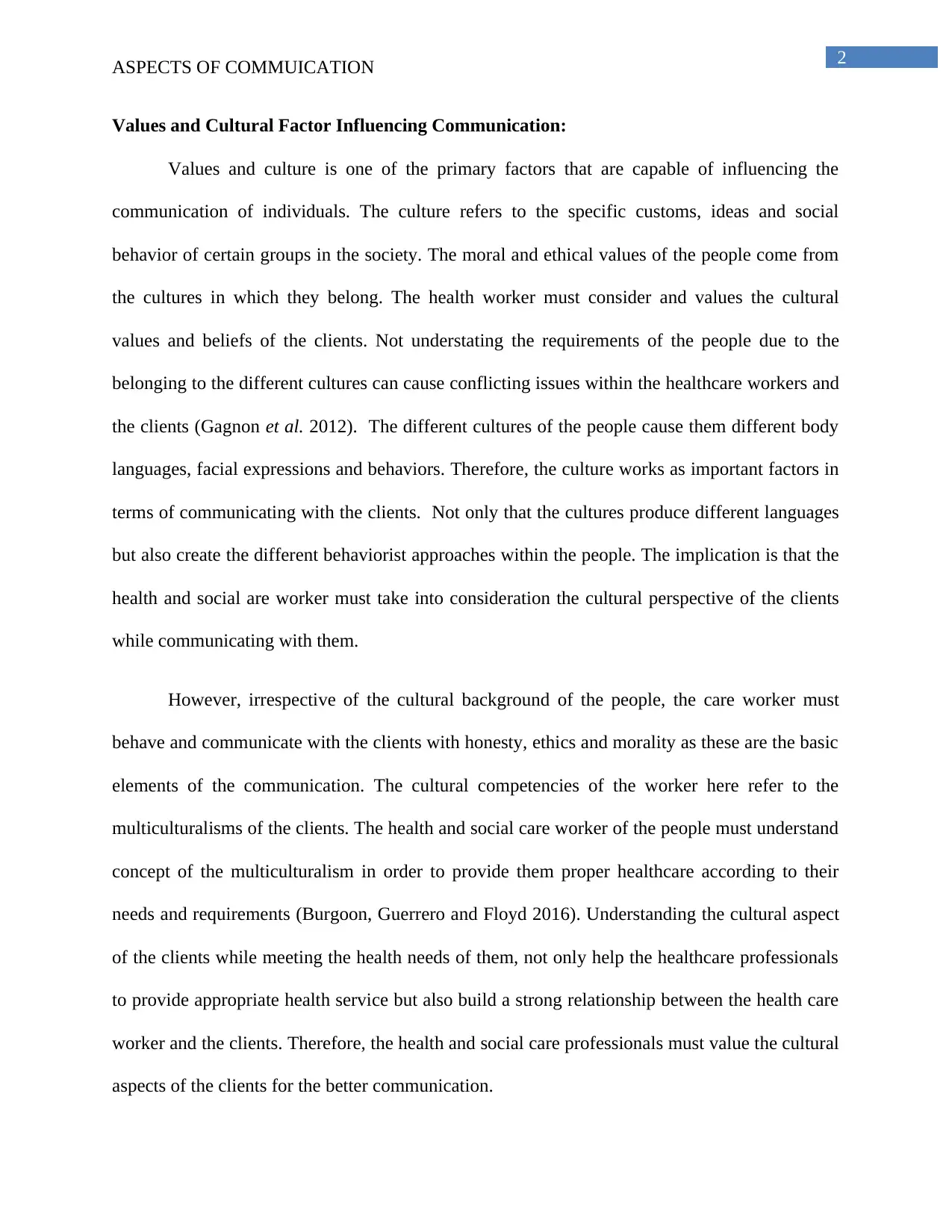
2
ASPECTS OF COMMUICATION
Values and Cultural Factor Influencing Communication:
Values and culture is one of the primary factors that are capable of influencing the
communication of individuals. The culture refers to the specific customs, ideas and social
behavior of certain groups in the society. The moral and ethical values of the people come from
the cultures in which they belong. The health worker must consider and values the cultural
values and beliefs of the clients. Not understating the requirements of the people due to the
belonging to the different cultures can cause conflicting issues within the healthcare workers and
the clients (Gagnon et al. 2012). The different cultures of the people cause them different body
languages, facial expressions and behaviors. Therefore, the culture works as important factors in
terms of communicating with the clients. Not only that the cultures produce different languages
but also create the different behaviorist approaches within the people. The implication is that the
health and social are worker must take into consideration the cultural perspective of the clients
while communicating with them.
However, irrespective of the cultural background of the people, the care worker must
behave and communicate with the clients with honesty, ethics and morality as these are the basic
elements of the communication. The cultural competencies of the worker here refer to the
multiculturalisms of the clients. The health and social care worker of the people must understand
concept of the multiculturalism in order to provide them proper healthcare according to their
needs and requirements (Burgoon, Guerrero and Floyd 2016). Understanding the cultural aspect
of the clients while meeting the health needs of them, not only help the healthcare professionals
to provide appropriate health service but also build a strong relationship between the health care
worker and the clients. Therefore, the health and social care professionals must value the cultural
aspects of the clients for the better communication.
ASPECTS OF COMMUICATION
Values and Cultural Factor Influencing Communication:
Values and culture is one of the primary factors that are capable of influencing the
communication of individuals. The culture refers to the specific customs, ideas and social
behavior of certain groups in the society. The moral and ethical values of the people come from
the cultures in which they belong. The health worker must consider and values the cultural
values and beliefs of the clients. Not understating the requirements of the people due to the
belonging to the different cultures can cause conflicting issues within the healthcare workers and
the clients (Gagnon et al. 2012). The different cultures of the people cause them different body
languages, facial expressions and behaviors. Therefore, the culture works as important factors in
terms of communicating with the clients. Not only that the cultures produce different languages
but also create the different behaviorist approaches within the people. The implication is that the
health and social are worker must take into consideration the cultural perspective of the clients
while communicating with them.
However, irrespective of the cultural background of the people, the care worker must
behave and communicate with the clients with honesty, ethics and morality as these are the basic
elements of the communication. The cultural competencies of the worker here refer to the
multiculturalisms of the clients. The health and social care worker of the people must understand
concept of the multiculturalism in order to provide them proper healthcare according to their
needs and requirements (Burgoon, Guerrero and Floyd 2016). Understanding the cultural aspect
of the clients while meeting the health needs of them, not only help the healthcare professionals
to provide appropriate health service but also build a strong relationship between the health care
worker and the clients. Therefore, the health and social care professionals must value the cultural
aspects of the clients for the better communication.
⊘ This is a preview!⊘
Do you want full access?
Subscribe today to unlock all pages.

Trusted by 1+ million students worldwide
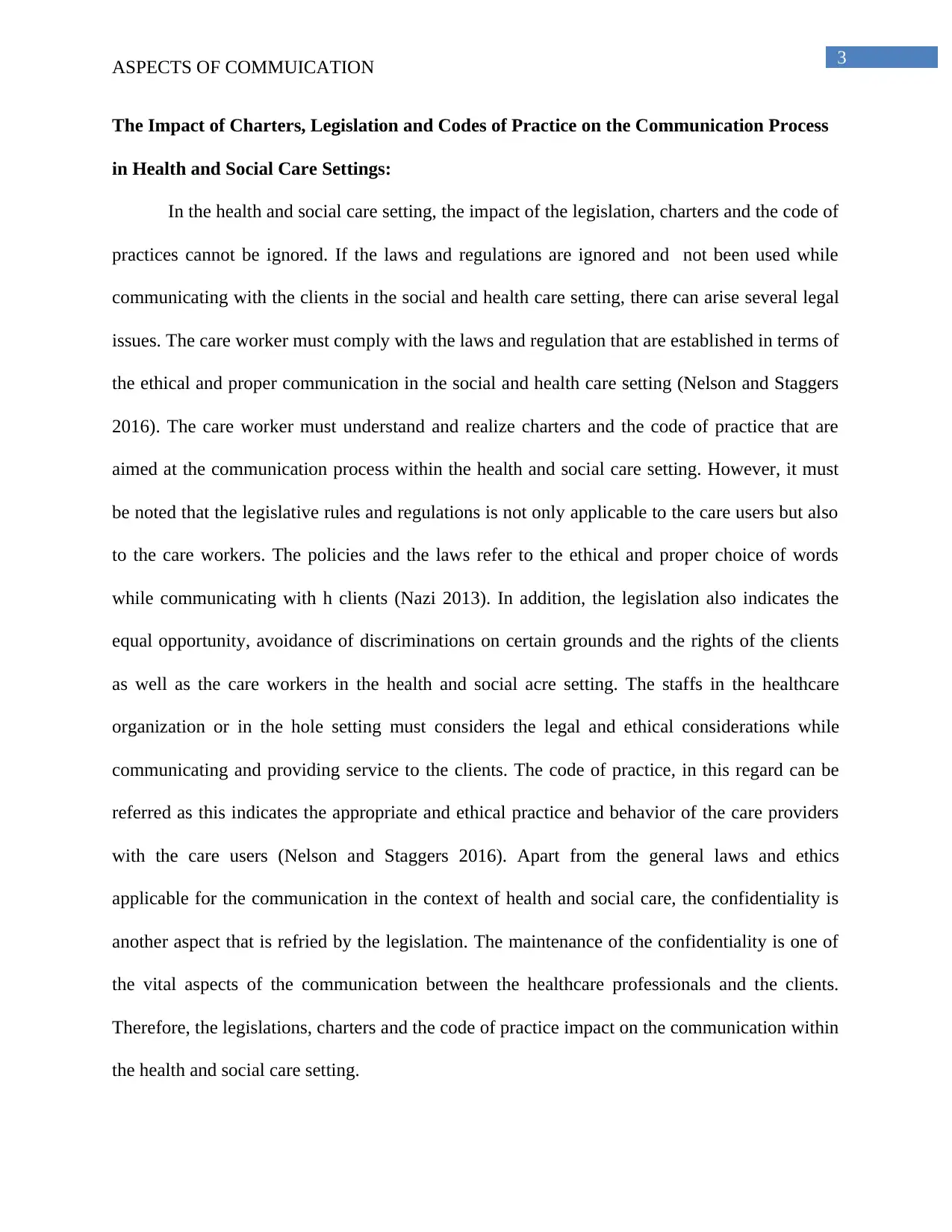
3
ASPECTS OF COMMUICATION
The Impact of Charters, Legislation and Codes of Practice on the Communication Process
in Health and Social Care Settings:
In the health and social care setting, the impact of the legislation, charters and the code of
practices cannot be ignored. If the laws and regulations are ignored and not been used while
communicating with the clients in the social and health care setting, there can arise several legal
issues. The care worker must comply with the laws and regulation that are established in terms of
the ethical and proper communication in the social and health care setting (Nelson and Staggers
2016). The care worker must understand and realize charters and the code of practice that are
aimed at the communication process within the health and social care setting. However, it must
be noted that the legislative rules and regulations is not only applicable to the care users but also
to the care workers. The policies and the laws refer to the ethical and proper choice of words
while communicating with h clients (Nazi 2013). In addition, the legislation also indicates the
equal opportunity, avoidance of discriminations on certain grounds and the rights of the clients
as well as the care workers in the health and social acre setting. The staffs in the healthcare
organization or in the hole setting must considers the legal and ethical considerations while
communicating and providing service to the clients. The code of practice, in this regard can be
referred as this indicates the appropriate and ethical practice and behavior of the care providers
with the care users (Nelson and Staggers 2016). Apart from the general laws and ethics
applicable for the communication in the context of health and social care, the confidentiality is
another aspect that is refried by the legislation. The maintenance of the confidentiality is one of
the vital aspects of the communication between the healthcare professionals and the clients.
Therefore, the legislations, charters and the code of practice impact on the communication within
the health and social care setting.
ASPECTS OF COMMUICATION
The Impact of Charters, Legislation and Codes of Practice on the Communication Process
in Health and Social Care Settings:
In the health and social care setting, the impact of the legislation, charters and the code of
practices cannot be ignored. If the laws and regulations are ignored and not been used while
communicating with the clients in the social and health care setting, there can arise several legal
issues. The care worker must comply with the laws and regulation that are established in terms of
the ethical and proper communication in the social and health care setting (Nelson and Staggers
2016). The care worker must understand and realize charters and the code of practice that are
aimed at the communication process within the health and social care setting. However, it must
be noted that the legislative rules and regulations is not only applicable to the care users but also
to the care workers. The policies and the laws refer to the ethical and proper choice of words
while communicating with h clients (Nazi 2013). In addition, the legislation also indicates the
equal opportunity, avoidance of discriminations on certain grounds and the rights of the clients
as well as the care workers in the health and social acre setting. The staffs in the healthcare
organization or in the hole setting must considers the legal and ethical considerations while
communicating and providing service to the clients. The code of practice, in this regard can be
referred as this indicates the appropriate and ethical practice and behavior of the care providers
with the care users (Nelson and Staggers 2016). Apart from the general laws and ethics
applicable for the communication in the context of health and social care, the confidentiality is
another aspect that is refried by the legislation. The maintenance of the confidentiality is one of
the vital aspects of the communication between the healthcare professionals and the clients.
Therefore, the legislations, charters and the code of practice impact on the communication within
the health and social care setting.
Paraphrase This Document
Need a fresh take? Get an instant paraphrase of this document with our AI Paraphraser
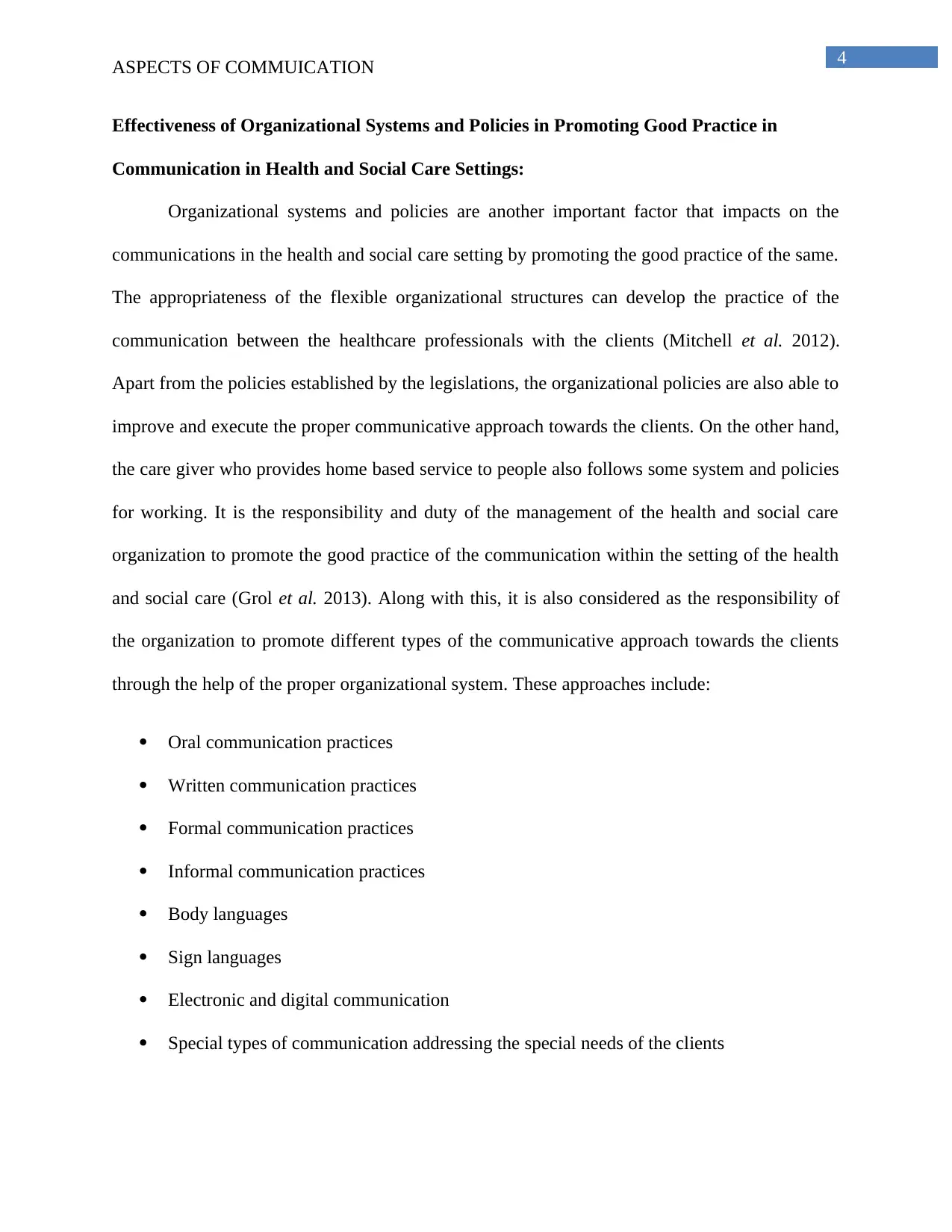
4
ASPECTS OF COMMUICATION
Effectiveness of Organizational Systems and Policies in Promoting Good Practice in
Communication in Health and Social Care Settings:
Organizational systems and policies are another important factor that impacts on the
communications in the health and social care setting by promoting the good practice of the same.
The appropriateness of the flexible organizational structures can develop the practice of the
communication between the healthcare professionals with the clients (Mitchell et al. 2012).
Apart from the policies established by the legislations, the organizational policies are also able to
improve and execute the proper communicative approach towards the clients. On the other hand,
the care giver who provides home based service to people also follows some system and policies
for working. It is the responsibility and duty of the management of the health and social care
organization to promote the good practice of the communication within the setting of the health
and social care (Grol et al. 2013). Along with this, it is also considered as the responsibility of
the organization to promote different types of the communicative approach towards the clients
through the help of the proper organizational system. These approaches include:
Oral communication practices
Written communication practices
Formal communication practices
Informal communication practices
Body languages
Sign languages
Electronic and digital communication
Special types of communication addressing the special needs of the clients
ASPECTS OF COMMUICATION
Effectiveness of Organizational Systems and Policies in Promoting Good Practice in
Communication in Health and Social Care Settings:
Organizational systems and policies are another important factor that impacts on the
communications in the health and social care setting by promoting the good practice of the same.
The appropriateness of the flexible organizational structures can develop the practice of the
communication between the healthcare professionals with the clients (Mitchell et al. 2012).
Apart from the policies established by the legislations, the organizational policies are also able to
improve and execute the proper communicative approach towards the clients. On the other hand,
the care giver who provides home based service to people also follows some system and policies
for working. It is the responsibility and duty of the management of the health and social care
organization to promote the good practice of the communication within the setting of the health
and social care (Grol et al. 2013). Along with this, it is also considered as the responsibility of
the organization to promote different types of the communicative approach towards the clients
through the help of the proper organizational system. These approaches include:
Oral communication practices
Written communication practices
Formal communication practices
Informal communication practices
Body languages
Sign languages
Electronic and digital communication
Special types of communication addressing the special needs of the clients
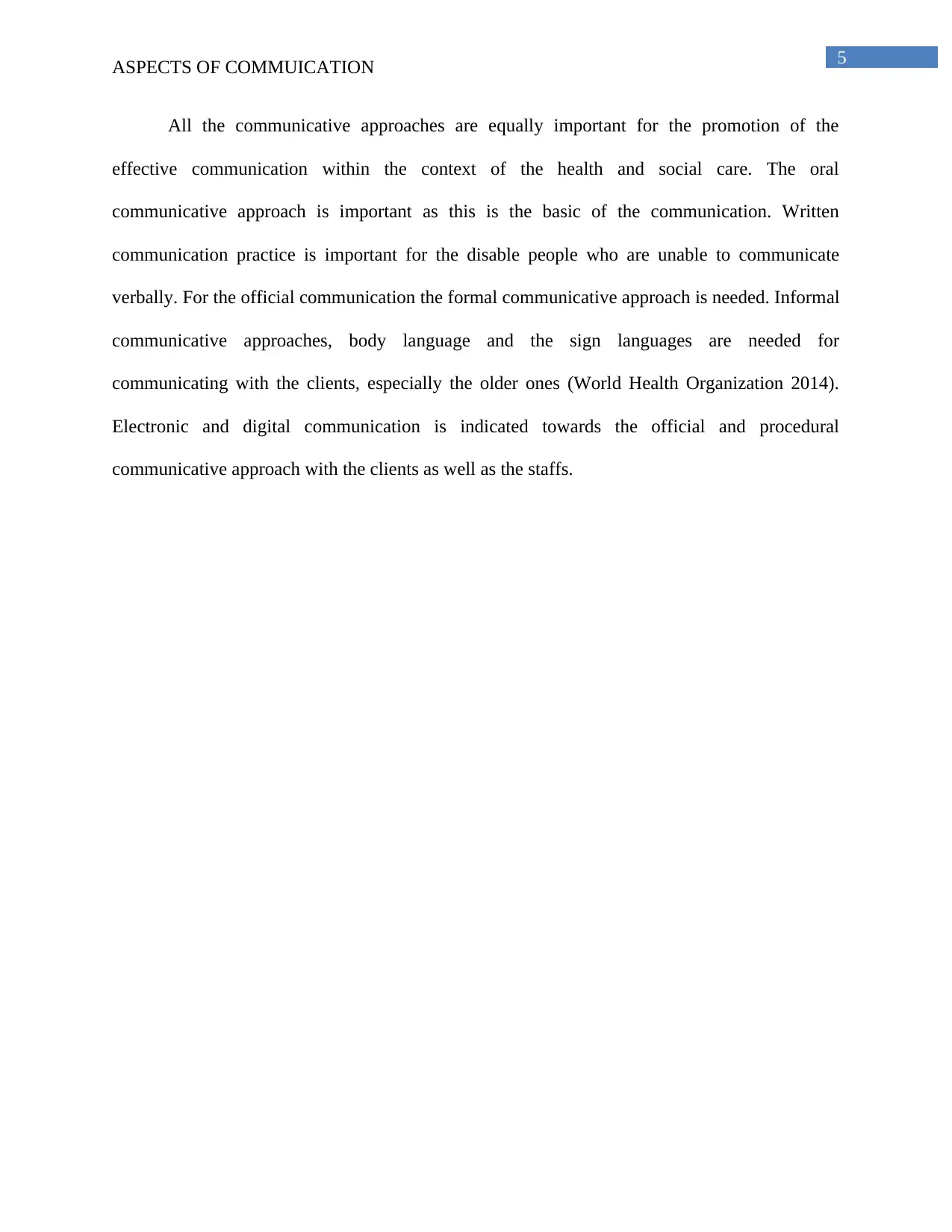
5
ASPECTS OF COMMUICATION
All the communicative approaches are equally important for the promotion of the
effective communication within the context of the health and social care. The oral
communicative approach is important as this is the basic of the communication. Written
communication practice is important for the disable people who are unable to communicate
verbally. For the official communication the formal communicative approach is needed. Informal
communicative approaches, body language and the sign languages are needed for
communicating with the clients, especially the older ones (World Health Organization 2014).
Electronic and digital communication is indicated towards the official and procedural
communicative approach with the clients as well as the staffs.
ASPECTS OF COMMUICATION
All the communicative approaches are equally important for the promotion of the
effective communication within the context of the health and social care. The oral
communicative approach is important as this is the basic of the communication. Written
communication practice is important for the disable people who are unable to communicate
verbally. For the official communication the formal communicative approach is needed. Informal
communicative approaches, body language and the sign languages are needed for
communicating with the clients, especially the older ones (World Health Organization 2014).
Electronic and digital communication is indicated towards the official and procedural
communicative approach with the clients as well as the staffs.
⊘ This is a preview!⊘
Do you want full access?
Subscribe today to unlock all pages.

Trusted by 1+ million students worldwide
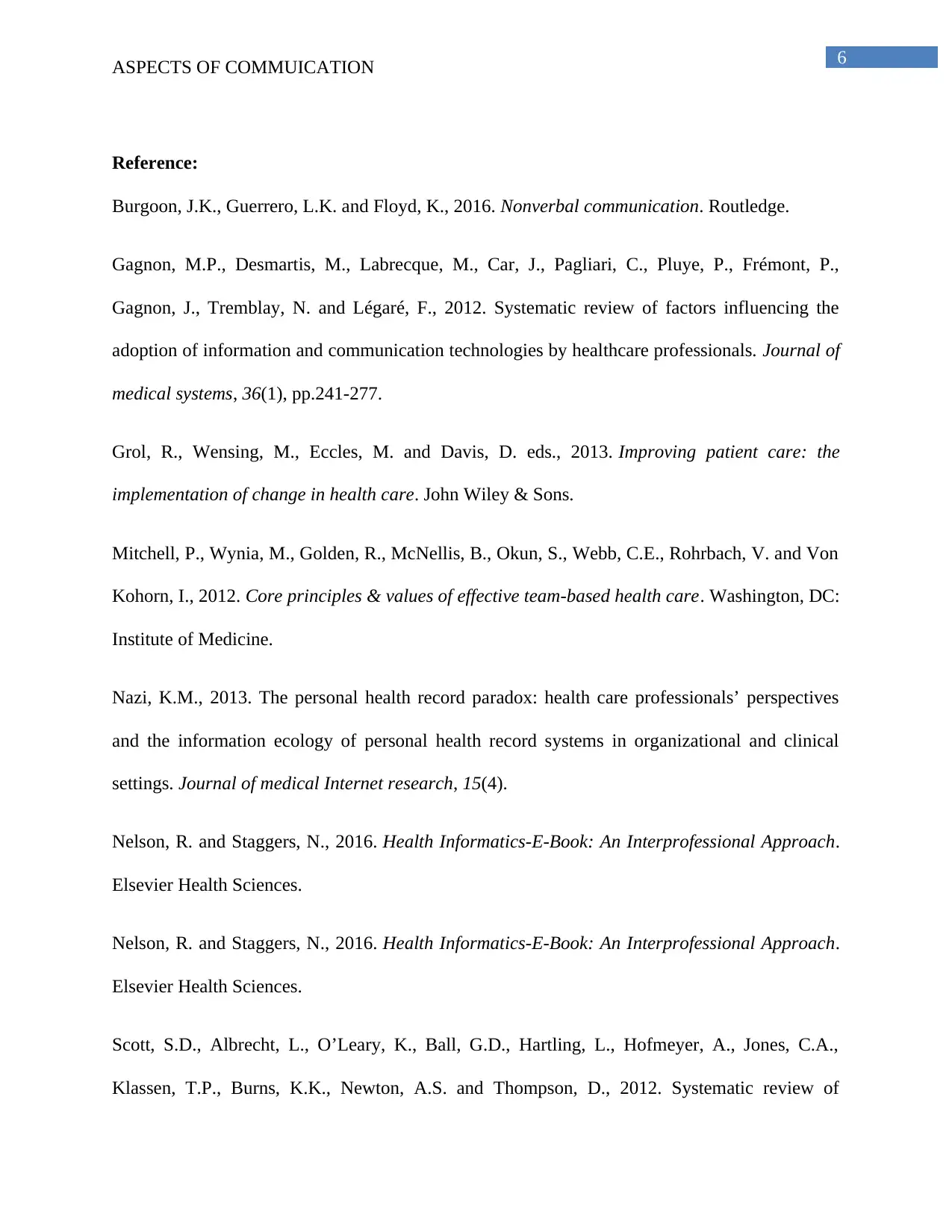
6
ASPECTS OF COMMUICATION
Reference:
Burgoon, J.K., Guerrero, L.K. and Floyd, K., 2016. Nonverbal communication. Routledge.
Gagnon, M.P., Desmartis, M., Labrecque, M., Car, J., Pagliari, C., Pluye, P., Frémont, P.,
Gagnon, J., Tremblay, N. and Légaré, F., 2012. Systematic review of factors influencing the
adoption of information and communication technologies by healthcare professionals. Journal of
medical systems, 36(1), pp.241-277.
Grol, R., Wensing, M., Eccles, M. and Davis, D. eds., 2013. Improving patient care: the
implementation of change in health care. John Wiley & Sons.
Mitchell, P., Wynia, M., Golden, R., McNellis, B., Okun, S., Webb, C.E., Rohrbach, V. and Von
Kohorn, I., 2012. Core principles & values of effective team-based health care. Washington, DC:
Institute of Medicine.
Nazi, K.M., 2013. The personal health record paradox: health care professionals’ perspectives
and the information ecology of personal health record systems in organizational and clinical
settings. Journal of medical Internet research, 15(4).
Nelson, R. and Staggers, N., 2016. Health Informatics-E-Book: An Interprofessional Approach.
Elsevier Health Sciences.
Nelson, R. and Staggers, N., 2016. Health Informatics-E-Book: An Interprofessional Approach.
Elsevier Health Sciences.
Scott, S.D., Albrecht, L., O’Leary, K., Ball, G.D., Hartling, L., Hofmeyer, A., Jones, C.A.,
Klassen, T.P., Burns, K.K., Newton, A.S. and Thompson, D., 2012. Systematic review of
ASPECTS OF COMMUICATION
Reference:
Burgoon, J.K., Guerrero, L.K. and Floyd, K., 2016. Nonverbal communication. Routledge.
Gagnon, M.P., Desmartis, M., Labrecque, M., Car, J., Pagliari, C., Pluye, P., Frémont, P.,
Gagnon, J., Tremblay, N. and Légaré, F., 2012. Systematic review of factors influencing the
adoption of information and communication technologies by healthcare professionals. Journal of
medical systems, 36(1), pp.241-277.
Grol, R., Wensing, M., Eccles, M. and Davis, D. eds., 2013. Improving patient care: the
implementation of change in health care. John Wiley & Sons.
Mitchell, P., Wynia, M., Golden, R., McNellis, B., Okun, S., Webb, C.E., Rohrbach, V. and Von
Kohorn, I., 2012. Core principles & values of effective team-based health care. Washington, DC:
Institute of Medicine.
Nazi, K.M., 2013. The personal health record paradox: health care professionals’ perspectives
and the information ecology of personal health record systems in organizational and clinical
settings. Journal of medical Internet research, 15(4).
Nelson, R. and Staggers, N., 2016. Health Informatics-E-Book: An Interprofessional Approach.
Elsevier Health Sciences.
Nelson, R. and Staggers, N., 2016. Health Informatics-E-Book: An Interprofessional Approach.
Elsevier Health Sciences.
Scott, S.D., Albrecht, L., O’Leary, K., Ball, G.D., Hartling, L., Hofmeyer, A., Jones, C.A.,
Klassen, T.P., Burns, K.K., Newton, A.S. and Thompson, D., 2012. Systematic review of
Paraphrase This Document
Need a fresh take? Get an instant paraphrase of this document with our AI Paraphraser
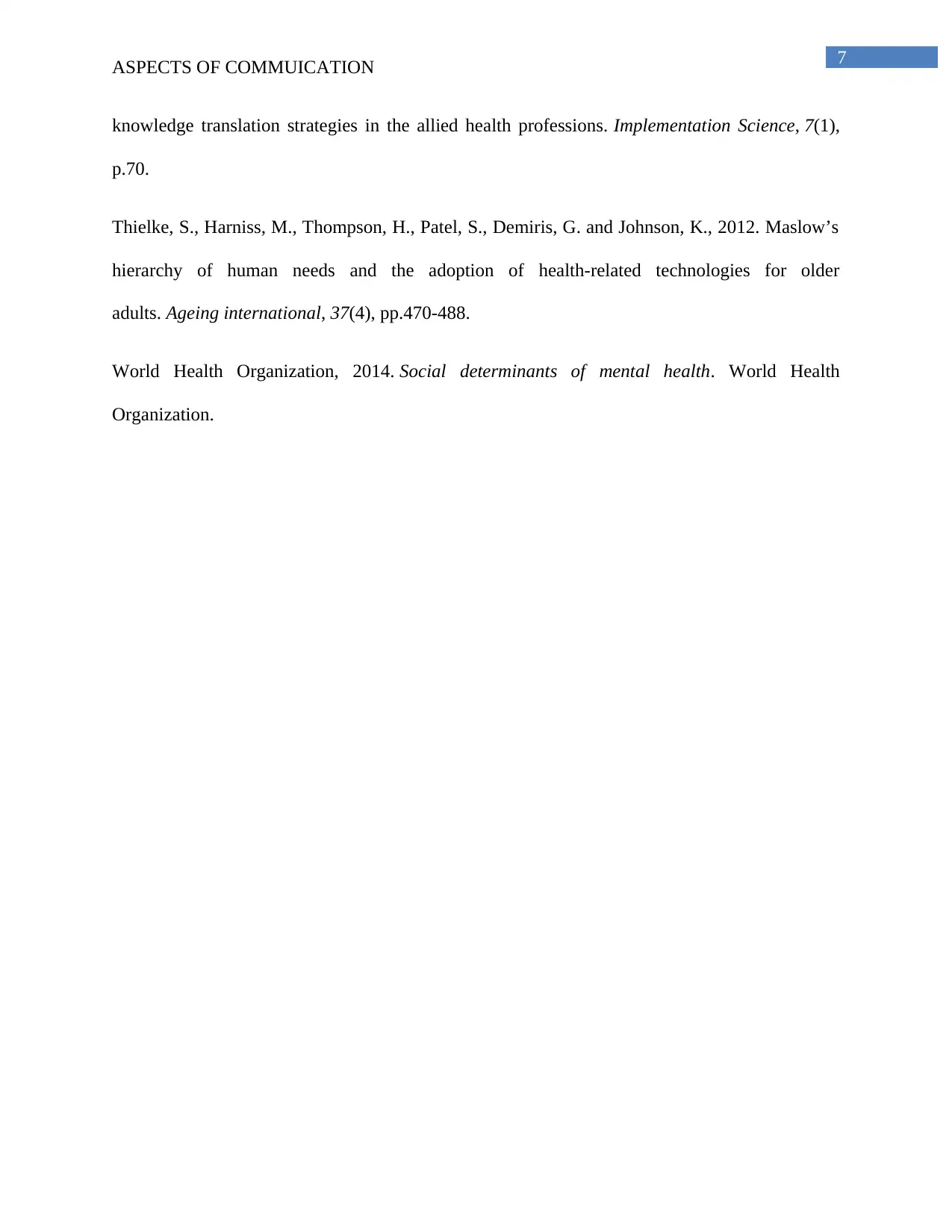
7
ASPECTS OF COMMUICATION
knowledge translation strategies in the allied health professions. Implementation Science, 7(1),
p.70.
Thielke, S., Harniss, M., Thompson, H., Patel, S., Demiris, G. and Johnson, K., 2012. Maslow’s
hierarchy of human needs and the adoption of health-related technologies for older
adults. Ageing international, 37(4), pp.470-488.
World Health Organization, 2014. Social determinants of mental health. World Health
Organization.
ASPECTS OF COMMUICATION
knowledge translation strategies in the allied health professions. Implementation Science, 7(1),
p.70.
Thielke, S., Harniss, M., Thompson, H., Patel, S., Demiris, G. and Johnson, K., 2012. Maslow’s
hierarchy of human needs and the adoption of health-related technologies for older
adults. Ageing international, 37(4), pp.470-488.
World Health Organization, 2014. Social determinants of mental health. World Health
Organization.
1 out of 8
Related Documents
Your All-in-One AI-Powered Toolkit for Academic Success.
+13062052269
info@desklib.com
Available 24*7 on WhatsApp / Email
![[object Object]](/_next/static/media/star-bottom.7253800d.svg)
Unlock your academic potential
Copyright © 2020–2025 A2Z Services. All Rights Reserved. Developed and managed by ZUCOL.





